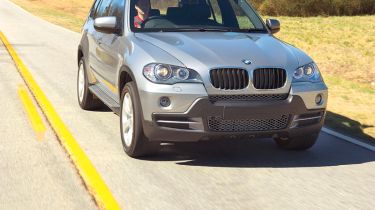BMW X5 review (2007)
The new X5 is improved over its predecessor in every way: bigger, more flexible and better to drive

The new X5 is improved over its predecessor in every way. It’s bigger, more flexible and better to drive, too. However, it’s not quite as revolutionary as the original model was when it first appeared in 1999, offering a more polished package rather than a groundbreaking leap forward. Still, innovations such as the front double wishbone suspension and electronic rear anti-roll bar send the BMW back to the top of the class in terms of on-road handling.
A blend of sharp styling and agile handling has always made BMW’s X5 tough to beat in the premium SUV class. However, with the likes of Porsche’s Cayenne challenging it for performance and the Land Rover Discovery offering more practicality, buyers are starting to look elsewhere.
Thanks to new underpinnings and the option of seven seats, the next-generation model has already impressed us in left-hand-drive form, and now we’ve taken the wheel of right-hand-drive models, too.
Video: watch CarBuyer's video review of the BMW X5
[[{"type":"media","view_mode":"content_narrow","fid":"68256","attributes":{"alt":"","class":"media-image"}}]]
The range is built in South Carolina in the US, and we took a UK-spec 3.0-litre diesel straight off the production line on a 500-mile test drive.
As you can see, designers haven’t strayed far from the shape that made the original X5 such a hit. It is 5cm taller, 6cm wider and 20cm longer than its predecessor, but retains many of the outgoing model’s muscular styling cues. The extra millimetres have seen the kerbweight grow to 2,200kg, yet that doesn’t stop it feeling like a sports saloon. Engineers have made the body stiffer and fitted double wishbone front suspension – a first for a production BMW.
For £2,300, you can have adaptive drive, which includes electronically controlled dampers and anti-roll bars. This gives the handling a further boost, and even when pushed hard, there’s not a hint of body roll. Buyers can also choose £910 active steering, which increases the angle of wheel turn depending on the speed, but it has a rather artificial feel.
However, we have no complaints about the revamped 232bhp 3.0-litre diesel. It’s both eight per cent more economical and more powerful than before, and is expected to account for three-quarters of UK sales. A 0-60mph time of 8.3 seconds shows just how swift the oil-burner is.
The unit is definitely better suited to the X5 than the new 4.8-litre V8 petrol powerplant. This has 350bhp, and propels the BMW from 0-60mph nearly two seconds faster, but the diesel unit’s torque advantage means there’s very little between the two in day-to-day driving. However, at the pumps, the oil-burner is a clear winner. It returns 32.5mpg compared to the petrol model’s 22.6mpg.
But while the X5 is class-leading on the road, over rough terrain it can’t match the Disco. The electronic hill descent system, which brakes individual wheels to control speed, is no sub-stitute for a low-ratio transfer box.
Yet the BMW can hold its own in terms of flexibility, as it’s now available with a third row of chairs for the first time. The bad news is that these seats are a £1,000 option, and space is cramped. But the rest of the cabin is roomy and comfortable.
Build quality is first class, although the new joystick-style electronic gear selector does feel a little cheap, which is disappointing when you consider the £40,120 price. However, with a waiting list already growing to several months, BMW has every right to be confident about the success of its new SUV.







